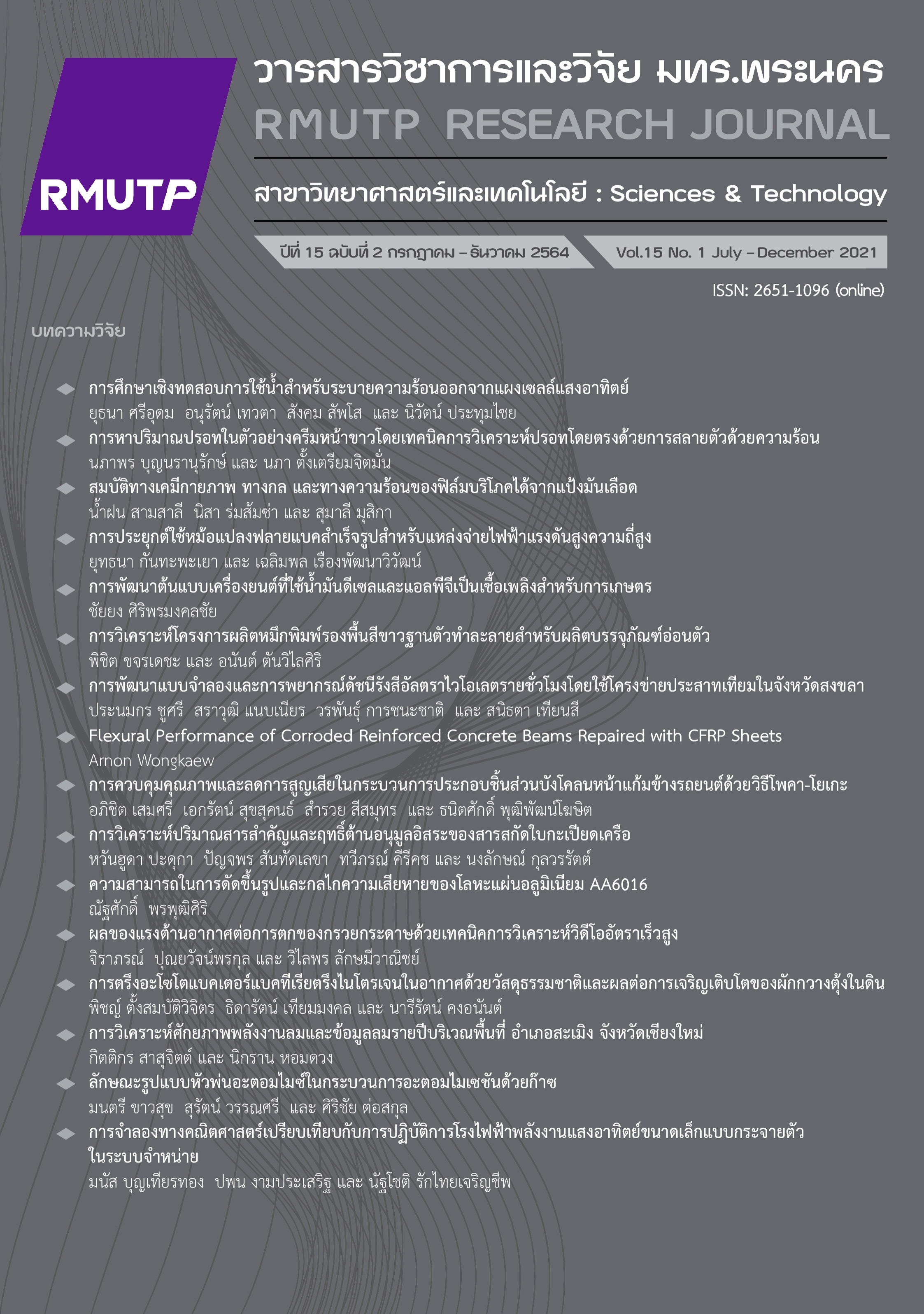Quality Control and Loss Reduction in the Front Side Fender Model Assembly Process Using Poka-Yoke Techniques
Main Article Content
Abstract
This study aimed to use Poka-Yoke techniques to help prevent errors and reduce loss in Front Side Fender Model assembly process. The researchers used four tools in the 7QC tools which were
Check Sheet, Cause-and-Effect Diagram and Graphs to search for causes and ways to solve problems and Cause and Effect Matrix and ECRS Techniques. The study revealed that the main cause of the problems was that the incorrect assembled side fenders were submitted to another department. This mistake had bad effects on time and workforce spent for correcting work including more expenses. The mistakes occurred because there was no tool for detecting errors in the work piece. Therefore, the researchers use Poka-Yoke techniques in order to decrease errors by designing a control system for target detection while it was moving through the process. After collecting data, the study showed that before the improvement during January to August 2019, the number of problems caused by the process were 0.093. However, the number of problems after the improvement during September to December 2019 reduced to 0. It was obvious that this improvement reduced the loss from the front side fender assembly process up to 100.
Article Details

This work is licensed under a Creative Commons Attribution-NonCommercial-NoDerivatives 4.0 International License.
ลิขสิทธ์ ของมหาวิทยาลัยเทคโนโลยีราชมงคลพระนครReferences
J.-C. Tsou and J.-M. Chen, “Dynamic model for a defective production system with Poka-Yoke,” Journal of the Operational Research Society, vol. 56, no. 7, pp. 799–803, Jul. 2005.
S. Shingo and A. P. Dillon, Zero Quality Control: Source Inspection and the Poka-Yoke System, Productivity Press, 1986.
S. Tkaczyk and M. Dudek, “Quality continuous improvement of production process in aspect of usage quality researches and estimation methods,” in Proceedings of 11th Scientific International Conference Achievements in Mechanical and Materials Engineering, AMME, Gliwice-Zakopane, 2002, pp. 567-570.
S. Tkaczyk and M. Dudek, “Methodology research of quality in industry,” in Proceedings of 7th Scientific International Conference Achievements in Mechanical and Materials Engineering, AMME, Gliwice-Zakopane, 1998, pp. 513-516.
C. Khunponkaew, Productivity Improvement Principle, 1st ed. Bangkok: Prachachon Publisher, Thailand Productivity Institute, 2001.
S. Tangphaitoon, 7 Waste Reduction by Kaizen for Production Improvement, 1st ed. Nonthaburi, 2004.
R. B. Chase, Production and Operations Management, 7th ed. McGraw-Hill, 1995.
K. Pipatpanyanukul, Quality Control, Top Textbook, 2014.
S. Nataphan, Quality Control, SE-ED Textbook, 2008.
C. Chakrad, S. Nattakorn and D. Phattharaphong, “Waste reduction in welding process of automotive suspension,” RMUTL Journal, vol. 7, no. 1, pp. 28-141, Jun. 2014.
H. Lachajczyk and M. Dudek-Burlikowska, “Quality continuous improvement of company with usage the Poka-Yoke methods,” PSKN 7, pp. 57-64, 2006.
M. Dudek-Burlikowska and D. Szewieczek, “The Poka-Yoke method as an improving quality tool of operations in the process,” Journal of Achievement in Materials and Manufacturing Engineering, vol. 36, pp. 95-102, Sep. 2009.
N. K. Shimbun, Improving Product Quality by Preventing Defects, Productivity Press, Cambridge, Massachusetts, 1998.
S. Patel, B. G. Dale and P. Shaw, “Set-up time reduction and mistake proofing methods: an examination in precision component manufacturing,” The TQM Magazine, vol. 13, no. 3, pp. 175-179, 2001.
M. Kittiyakajon, “Application of Analytic Hierarchy Process to Select Quality Improvement for Defect Reduction Projects: A Case Study of Air Tank Manufacturer,” journal of Engineering RMUTT, vol. 2, pp. 71-83, Aug. 2018.
P. Akarathompongse, Waste Reduction with ECRS principles. Institute for small and Medium Enterprises Development, 2005.
T. L. Satty, The Analytic Hierarchy Process, New York: McGraw-Hill, 1980.
Lee Ing Yi, Sha’ri Mohd Yusof, “Product quality improvement through poka-yoke technique”Journal Mekanikal, no. 23, pp. 74-82, Jun. 2007.
P.Nanjundaraj, V.Kannan, P.Sangeetha and S.Umamaheswari, “A Study on implementation of POKA–YOKE technique in improving the operational performance by reducing the rejection rate in the assembly Line” International Journal of Pure and Applied Mathematics, vol. 119, no. 17, pp. 2177-2191, 2018.
K. Ploypanichcharoen, Principle of quality control, Technology Promotion Association (Thailand-japan), 2007.
C. Surasak and K. Rapee, “Product quality improvement in plastic injection process by statistical quality control,” in Proceeding of 15th RSU National Graduate Research Conference , Rangsit Univesity, 2020, pp. 2369-2381.
W. Jirawat et al., “Waste reduction in a manufacturing process: A Case Study of dadear Ceramics Factory in lampang provice,” RMUTP Research Journal, vol. 10, no. 2, pp. 43-53, Sep. 2016.


